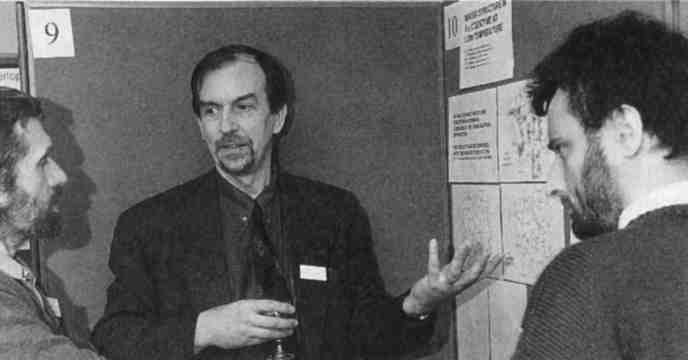


Meeting report
Neutron and X-ray Scattering Studies of Biological Systems
 John3 (J. Finney, J. Squire and J. Bouquire) discuss results of crystallographic studies of water structure in B12 coenzyme during the evening poster session.
John3 (J. Finney, J. Squire and J. Bouquire) discuss results of crystallographic studies of water structure in B12 coenzyme during the evening poster session.
A workshop on Neutron and X-ray Scattering Studies of Biological Systems was organized by the Institute of Physics and Faraday Division of the Royal Society of Chemistry, sponsored by the Wellcome Trust and held at Keele University in April 1994. The aim of the meeting was to promote the applications of neutron scattering to the study of biological systems and to provide a forum for the discussion of recent results and future developments.
B. Schoenborn (Los Alamos National Lab. USA) opened the program with an account of the way in which neutron diffraction has been used in the study of the hydration of myoglobin and a method by which phase information can be improved by refining the occupancies and temperature factors of hydration shells around the protein. P. Langan (Keele U.) described complementary neutron and X-ray high angle fiber diffraction studies of the location of ions and water around DNA. P. Timmins (ILL, Grenoble), emphasized the possibilities for exploiting contrast variation in low resolution neutron biological crystallography. In his studies of purple membrane, deuterium labeling allowed details of the location of the chromophore to be determined. High resolution X-ray and neutron data were used to locate ordered solvent in the "pocket" region of the vitamin Bl2 coenzyme (P. Lindley). The structure and condensation mechanisms of chromatin multinucleosomes were studied by neutron and X-ray scattering, photon correlation spectroscopy, electrical conductivity, and gel filtration experiments (J. Baldwin, Liverpool John Moores U.). C. Carlisle (Rutherford Appleton Lab.) described "Long wavelength diffraction on IRIS - an opportunity for biologists?" stressing the use of powder diffraction for the study of biological systems. T. Wess (Edinburgh U. Medical School) talked about neutron diffraction studies of in vitro binding of acetaldehyde to collagen and their relation to cirrhosis and fibrosis of the liver. G. Grossmann (Daresbury Lab.) combined X-ray solution scattering data, molecular modeling, and single crystal experiments to study conformational changes and hydration.
C. Wilson (Rutherford Appleton Lab.) described opportunities for structural biologists using pulsed neutrons. The potential of time-of-flight Laue diffraction was outlined and the problems and potential solutions in this area were discussed with reference to sources and instrumentation. J. Finney (U. College, London) described how neutron scattering techniques can be used to probe water perturbations close to nonpolar groups and to investigate conventional ideas about the hydrophobic effect. S. Perkins (Royal Free Hospital) presented neutron and X-ray solution scattering studies of low density lipoproteins (LDL) in plasma to illustrate structural changes associated with oxidation that plays a key role in atherosclerosis. J. Tomkinson (Rutherford Appleton Lab.) explored "Hydrogen Bonds in Peptides" using inelastic neutron scattering. Two systems were described in which the hydrogen atoms involved in hydrogen bonds are dynamically decoupled from the heavy atom system. H. Grimm (Jülich) described neutron elastic and inelastic studies of oriented DNA. The results show compressional modes along the helix as well as the so-called lowest Raman mode which softens dramatically in approaching ambient temperature.
Potential new applications should stimulate innovative bids for beam time at ILL (Inst. Laue Langevin) and ISIS.
Trevor ForsythU. Keele, UK


